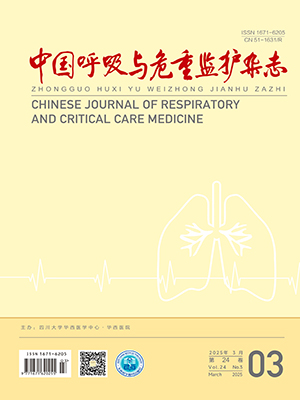Objective To explore whether interleukin-10 ( IL-10 ) gene single nucleotide polymorphisms are associated with asthma. Methods The frequency of three single nucleotide polymorphisms ( rs1800896, rs3024492, and rs3024496) and haplotypes of IL-10 gene were analysed in 302 adult asthmatic subjects and 275 controls of Han Chinese in Guangzhou using MALDI-TOF-MS and MassARRAY-IPLEX. The genotype and allele frequencies were analyzed by Chi-square test in both groups.
Logistic regression analysis with adjustment for age and sex was conducted. Odds ratio ( OR) and 95%confidence interval ( 95% CI) were calculated to analyze the associations between the susceptibility of asthma and genotypes. Results ①Three genotypes GG, GA, and AA of rs1800896 were found in Han Chinese in
Guangzhou. The frequencies of GG, GA, and AA genotypes were 2. 12% , 39. 65% , and 58. 23% ,respectively. The relative risk of developing asthma in the carriers of GA was significantly higher than that in the carriers of AA ( OR=4. 827, P lt;0. 001) . ②Two genotypes AA and AT of rs3024492 were found in Han Chinese in Guangzhou. The frequencies of AA and AT genotypes were 1. 22% and 98. 78% , respectively.The rs3024492 polymorphism was not related to susceptibility in asthma. ③Two genotypes TT and CT of rs3024496 were found in Han Chinese in Guangzhou. The frequencies of TT and CT genotypes were 90. 59% and 9. 41% , respectively. The rs3024496 polymorphism was not related to susceptibility in asthma. Conclusion In IL-10 gene single nucleotide polymorphisms, rs1800896 but not rs3024492 and rs3024496 is
statistically related with the development of asthma.
Citation: YANG Xuexi,LI Fenxia,LI Xin,SUN Jingzhe,SUN Minying,LI Ming. Association of Single Nucleotide Polymorphisms in Interleukin-10 Gene with Asthma. Chinese Journal of Respiratory and Critical Care Medicine, 2010, 9(5): 485-489. doi: Copy
Copyright © the editorial department of Chinese Journal of Respiratory and Critical Care Medicine of West China Medical Publisher. All rights reserved




